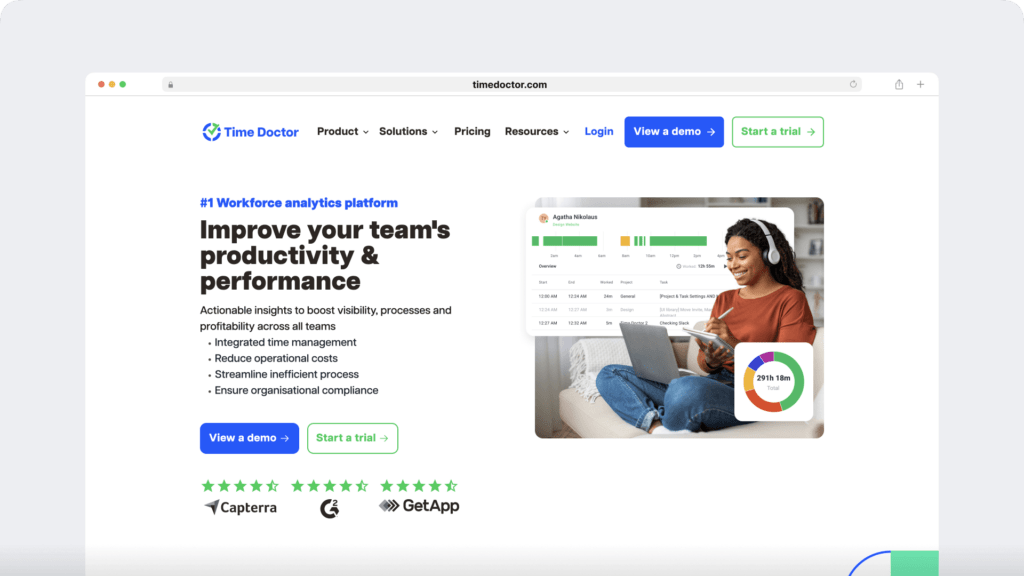Many companies focus on productivity metrics that are easy to track, like hours worked, task completion, employee time tracking, or online presence. These numbers create a sense of control, but they rarely reflect how work happens or how teams are feeling.
Imagine a team member who consistently hits deadlines, works longer hours, and picks up extra tasks.
Their performance looks strong in the system. But without visibility into their workload or well-being, it’s easy to miss early signs of burnout or disengagement.
As Prioridata reports, “Imagine a world where 87% of organisations use the power of advanced analytics to unlock their workforce potential and reduce employee turnover by up to 35%.” This is where workforce analytics becomes essential.
Workforce analytics empowers leaders to understand how time is spent, identify hidden risks, and support individuals before challenges arise.
This shift leads to stronger retention, healthier teams, and improved performance across remote, hybrid, and in-office environments.
When traditional metrics fall short, the signals from your highest-performing people get lost. That’s why it’s important to shift the conversation from time spent to value created.
In the next section, we’ll walk through three common productivity myths. These beliefs still shape how many teams operate today, but they often create more pressure than progress.
Understanding them is the first step toward building a healthier, high-performing workforce.
What we’ll cover
Myth 1: More hours equal better performance
It’s common to associate long hours with high productivity. But time spent at a desk doesn’t always reflect meaningful progress. Without context, it’s easy to overlook what actually drives outcomes.
One BPO company used Time Doctor’s workforce analytics across 450 remote agents over six months. They found remote workers cut unproductive time by 56% and increased productive hours by 44% compared to their in-office counterparts .
With clearer visibility powered by productivity analytics, managers supported a shift in focus.. Team members began spending more time on high-priority tasks. Output increased without extending the workday.
This reflects what happens when leaders use data to support, rather than control. Time Doctor helped the team understand how work was happening, which led to more effective coaching, smarter planning, and greater trust across the board.
If you’d like to see how other teams are applying the same approach, our webinar shares real-world stories from thousands of companies using analytics to improve focus and performance across distributed teams.
Myth 2: Burnout is only visible in exit interviews
Burnout doesn’t begin with a resignation. It usually starts with small signs that get missed, especially when high performers stay quiet and push through heavy workloads.
Imagine a team leader caught off guard by a sudden resignation. During the exit conversation, the employee explains they had been quietly taking on most of the team’s responsibilities for months.
The imbalance wasn’t obvious. Without visibility into how work was distributed, there was no opportunity to step in earlier.
This kind of scenario is avoidable when leaders have access to real-time insights into attendance, performance patterns, and workload trends.
Peak Support, a global company, used Time Doctor’s workforce analytics to see how time was spent across their teams. With clear visibility into both productive and inactive hours, managers identified early signs of performance gaps.
This opened up supportive conversations before any issues impacted team well-being or delivery.
Taking early action helped them protect their people and improve retention across their distributed workforce.
Examples like this demonstrate how workforce analytics enables leaders to guide performance, rebalance workloads, and foster a healthier environment for high performers to thrive.
Myth 3: If someone is overwhelmed, they’ll speak up
Many leaders assume that someone who is struggling will speak up. In reality, top performers often power through quietly until they can’t.
That’s why relying on one-on-one check-ins or intuition alone doesn’t give you the full picture.
Workforce analytics and employee monitoring reveal hidden patterns, like regularly logging in late on Fridays or working weekends, that suggest someone’s workload is becoming unsustainable.
Sarv, a global technology services company, discovered just that when they implemented Time Doctor’s work‑life balance insights.
The software flagged frequent after‑hours and weekend work through its unusual activity report, helping managers spot potential issues early, which was causing fatigue and stress.
With that information, managers adjusted schedules and encouraged healthier boundaries.
As a result, team members reported more precise focus and better work-life balance within weeks.
4 powerful insights you get from workforce analytics
1. Burnout before it happens
Spot rising after-hours work, skipped breaks, and overextended contributors early, so you can support them before they disengage.
2. Quiet top performers who never ask for help
Visibility into effort, output, and focus helps you recognise consistent contributors, even if they work silently behind the scenes.
3. Workload imbalances that lead to turnover
See who’s carrying more than their share and rebalance early before it becomes a resignation risk.
4. Real output instead of busywork
Focus on deep work, value-added tasks, and where time actually goes, not just how long someone stays logged in.
Workforce analytics gives you more than just numbers. It provides the clarity to lead with trust, coach with context, and plan with confidence.
How can Time Doctor track the right metrics?

When teams rely on surface metrics like hours logged or online status, it’s easy to miss early signs of burnout, imbalance, or lost focus.
Time Doctor helps leaders move beyond that by using features designed to show what’s actually driving performance, without adding friction or micromanagement.
Here’s how it works across your entire workforce:
1. See where focus thrives and where it drifts
Instead of just tracking time, Time Doctor highlights how that time is spent.
You’ll get visibility into:
- Where time goes across projects, tools, and tasks
- Focused vs. idle time to understand deep work patterns
- Trends that show when attention shifts or bottlenecks appear
This helps managers coach with clarity, improve time management, and plan focused workdays that support better outcomes.
2. Support balance with early workload signals
Burnout builds quietly. Time Doctor helps teams stay ahead of it by surfacing:
- After-hours or weekend activity trends
- Missed breaks and overextended sessions
- Work-life balance patterns that highlight rising pressure
With early signals, leaders can rebalance workload, protect team energy, and retain top talent.
3. Recognize consistent contributors, even the quiet ones
Not everyone speaks up. Time Doctor helps you spot steady, high-value work through:
- Consistent focus and output trends
- Task completion linked to time investment
- Subtle shifts in behavior that reveal when someone might need support
You gain the insight to reward great work and step in before performance starts to dip.
4. Build trust through visibility, not control
Time Doctor delivers clarity without compromise.
With privacy-first screen monitoring, role-based access, and seamless integrations, you get:
- Context, not just activity
- Dashboards built for people leaders, not surveillance
- A system that respects autonomy while supporting results
It’s how modern managers lead with clarity, confidence, and trust.
Ready to refocus on what really matters? Get a demo to see how Time Doctor helps your team stay aligned, energised, and on track.

Carlo Borja is the Content Marketing Manager of Time Doctor, a workforce analytics software for distributed teams. He is a remote work advocate, a father and an avid coffee drinker.


